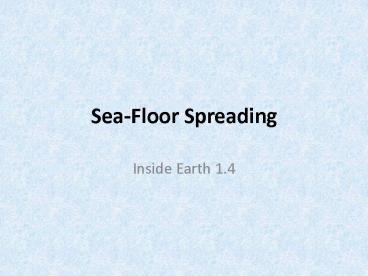SeaFloor Spreading - PowerPoint PPT Presentation
1 / 29
Title:
SeaFloor Spreading
Description:
Sonar is a device that bounces sound waves off underwater objects ... have found strange rocks shaped like pillows in the central valley of the mid-ocean ridge. ... – PowerPoint PPT presentation
Number of Views:80
Avg rating:3.0/5.0
Title: SeaFloor Spreading
1
Sea-Floor Spreading
- Inside Earth 1.4
2
Objectives
- describe the process of sea-floor spreading
- describe what happens to the ocean floor at
deep-ocean trenches.
3
mid-ocean ridge
- The longest chain of mountains in the world is
the mid-ocean ridge.
4
- In the mid-1900s, scientists mapped the mid-ocean
ridge using sonar.
5
Sonar
- Sonar is a device that bounces sound waves off
underwater objects and then records the echoes of
these sound waves.
6
- The mid-ocean ridge curves along the sea floor,
extending into all of Earths oceans.
7
- Most of the mountains in the mid-ocean ridge lie
hidden under hundreds of meters of water.
8
- A steep sided valley splits the top of the
mid-ocean ridge for most of its length.
9
- Earths ocean floors move like conveyor belts,
carrying the continents along with them. - This movement begins at the mid-ocean ridge.
10
- The ridge forms along a crack in the oceanic
crust.
11
- At the mid-ocean ridge, molten material rises
from the mantle and erupts. - The molten material then spreads out, pushing
older rock to both sides of the ridge.
12
- As the molten material cools, it forms a strip of
solid rock in the center of the ridge.
13
- Then more molten material splits apart the strip
of solid rock that formed before, pushing it
aside.
14
- This process, called sea-floor spreading,
continually adds new material to the ocean floor.
15
- Scientists have found strange rocks shaped like
pillows in the central valley of the mid-ocean
ridge.
16
- Such rocks can form only if molten material
hardens quickly after erupting under water. - The presence of these rocks supports the theory
of sea-floor spreading.
17
- More support came when scientists discovered that
the rock that makes up the ocean floor lies in a
pattern of magnetized stripes.
18
- The pattern is the same on both sides of the
ridge. - These stripes hold a record of reversals in
Earths magnetic field.
19
- The final proof of sea-floor spreading came from
rock samples obtained by drilling into the ocean
floor.
20
- Scientists found that the farther from the ridge
the rocks were taken, the older they were.
21
- The ocean floor does not just keep spreading.
- Instead, it sinks beneath deep underwater canyons
called deep-ocean trenches.
22
Subduction
- Where there are trenches, subduction takes place.
- Subduction is the process by which the ocean
floor sinks beneath a deep-ocean trench and back
into the mantle.
23
- At deep-ocean trenches, subduction allows part of
the ocean floor to sink back into the mantle,
over tens of millions of years.
24
- The processes of subduction and sea-floor
spreading can change the size and shape of the
oceans.
25
- Because of these processes, the ocean floor is
renewed about every 200 million years.
26
- The Pacific Ocean is shrinking.
- Its many trenches are swallowing more ocean crust
than the mid-ocean ridge is producing.
27
- The Atlantic Ocean is expanding.
- In most places, the oceanic crust of the Atlantic
Ocean is attached to continental crust.
28
- As the Atlantics floor spreads, the continents
along its edges also move.
29
END































